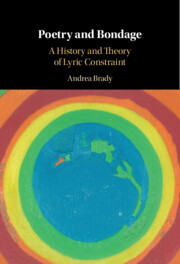Book contents
- Poetry and Bondage
- Poetry and Bondage
- Copyright page
- Dedication
- Contents
- Illustrations
- Acknowledgements
- Introduction The Fetters of Verse
- Part I Lyric Cells
- Part II The Songs of Slavery
- Chapter 5 Bind Me – I Still Can Sing
- Chapter 6 The Story that Cannot Be Told
- Chapter 7 The Sound Came from Everywhere and Nowhere
- Chapter 8 Singing at the Window
- Part III Pleasures and Ornaments
- Index
Chapter 7 - The Sound Came from Everywhere and Nowhere
African American Song as Lyric Work
from Part II - The Songs of Slavery
Published online by Cambridge University Press: 08 October 2021
- Poetry and Bondage
- Poetry and Bondage
- Copyright page
- Dedication
- Contents
- Illustrations
- Acknowledgements
- Introduction The Fetters of Verse
- Part I Lyric Cells
- Part II The Songs of Slavery
- Chapter 5 Bind Me – I Still Can Sing
- Chapter 6 The Story that Cannot Be Told
- Chapter 7 The Sound Came from Everywhere and Nowhere
- Chapter 8 Singing at the Window
- Part III Pleasures and Ornaments
- Index
Summary
This chapter turns to the sorrow songs, beginning with the famous passage from Frederick Douglass’s autobiographies. It focuses on the ethnography of African American song traditions in the late nineteenth and early twentieth centuries, a period of professionalisation of folklore studies in the American academy. White folklorists claimed the songs were irrational, primitive, childlike, unmediated expressions of feeling; other qualities were discovered by African American ethnographers, including Zora Neale Hurston. The songs were also forms of exploitative labour. The chapter includes a reading of Paul Laurence Dunbar’s poem ‘A Corn Song’. Dunbar’s shifts between African American vernacular and ‘standard’ English illuminate the tendency of white folklorists to call attention to the failure of the printed and disembodied textual transcription to transmit the real power of the performed lyric. The chapter considers the attempt to secure an ‘authentic’ Black sound through recordings in prisons and labour camps. It also challenges the notion of authenticity through a reading of Olio by Tyehimba Jess, a work that seeks to recover – through a form of poetic ventriloquy – the thoughts and feelings of the artists whose work was appropriated by white critics, scholars and producers in this period.
Keywords
- Type
- Chapter
- Information
- Poetry and BondageA History and Theory of Lyric Constraint, pp. 209 - 245Publisher: Cambridge University PressPrint publication year: 2021

